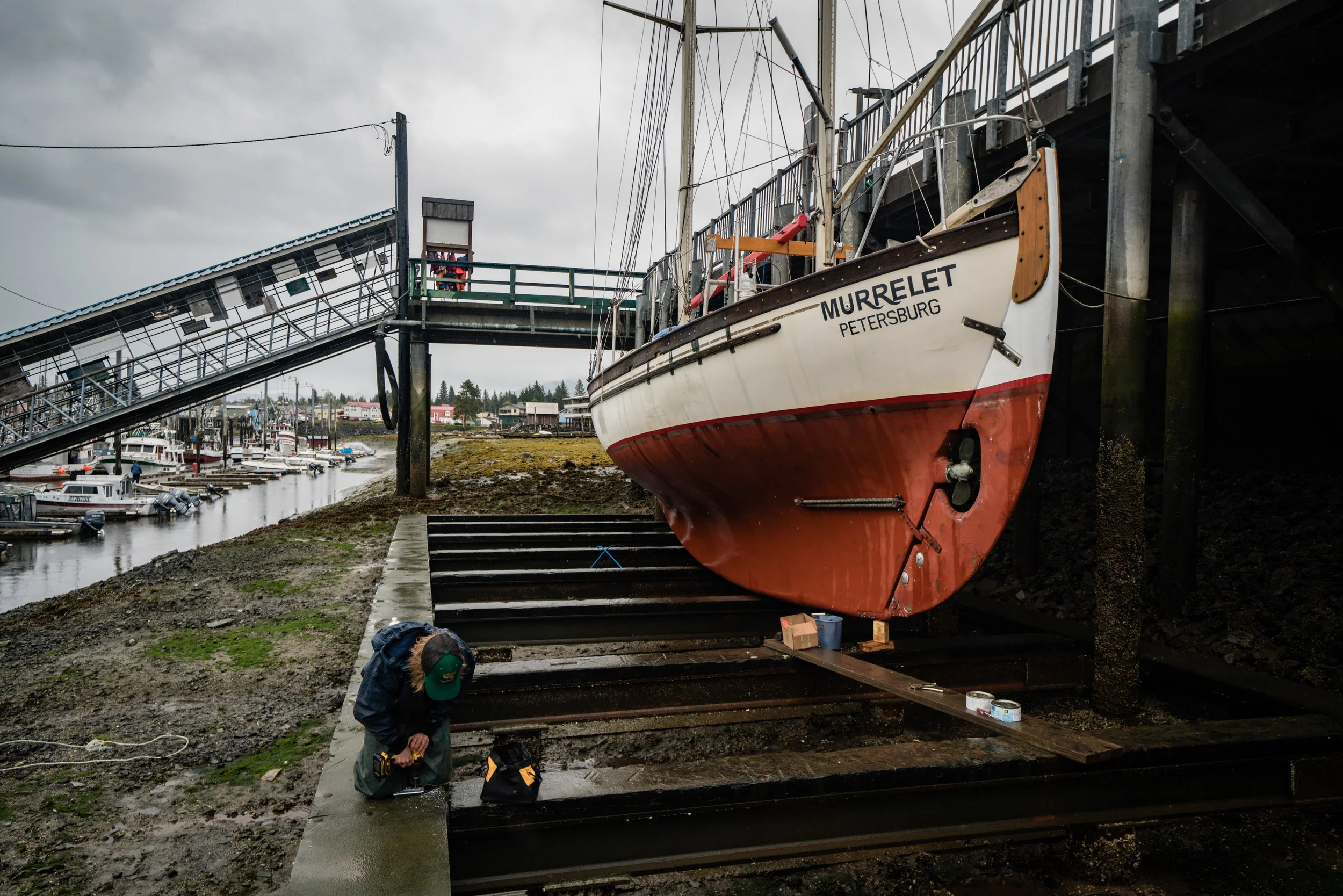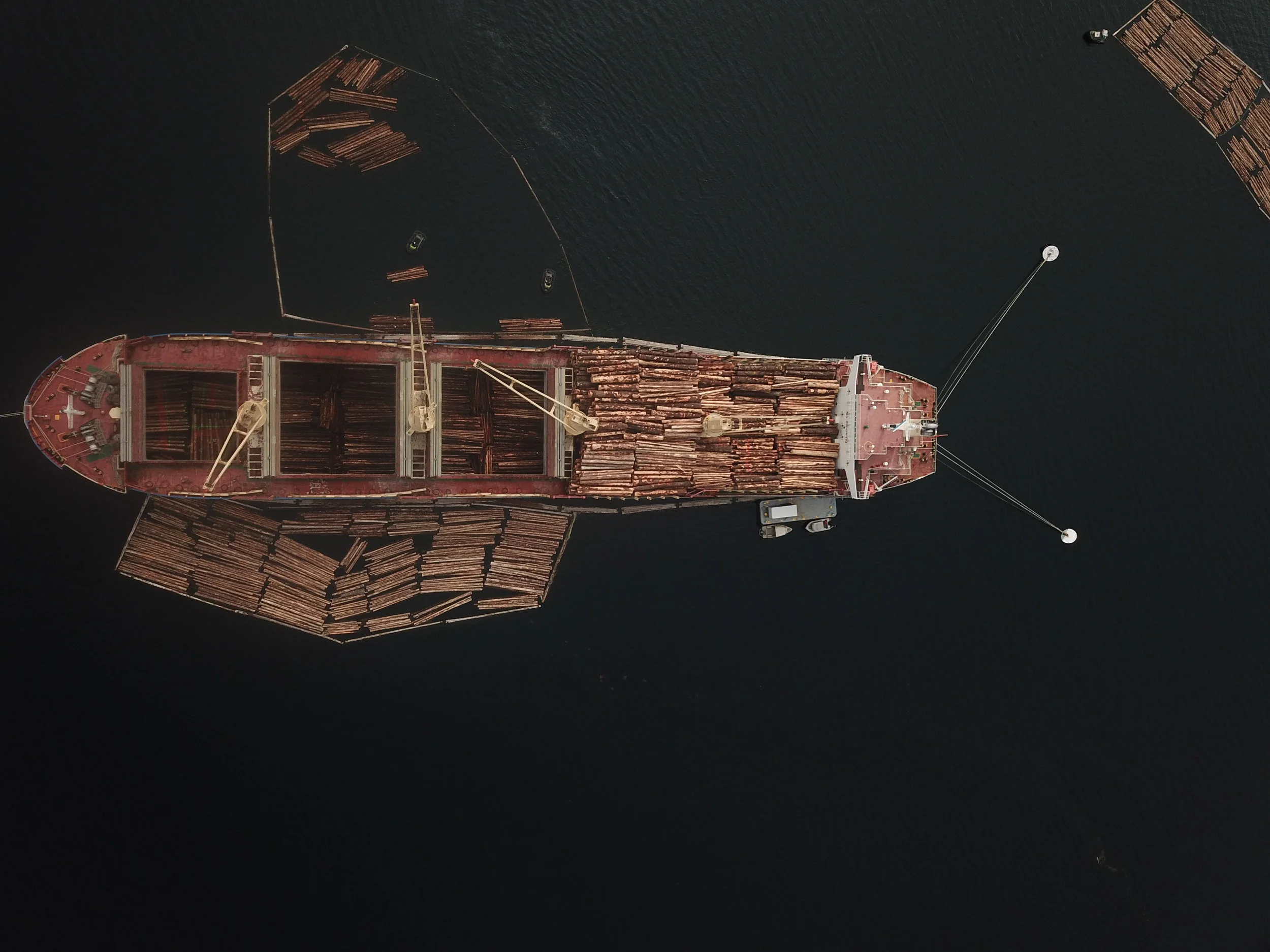Adventure in the Anthropocene
The Last Stands team set out in May 2019 aboard my 38-foot sailboat, the Murrelet. The boat was loaded with camera gear, kayaks, and a makeshift hammock filled with enough citrus to ward off scurvy over the next month of sailing, bushwhacking, and cramped quarters.
We came together as a hodgepodge group of young people: I’m a commercial fisherman and activist, Mara’s a scientific illustrator (who was still thawing out after a research season in the Arctic), Gleb is a freelance videographer, and Colin runs a media production company. Our final crewmate, Natalie, joined us later on in the trip; she’s recently taken the role of Executive Director at Audubon Alaska, and so her schedule is a little less amenable to the vagaries of ocean travel.
Boat work just days before we embark on our voyage. Photo: Colin Arisman.
The rest of us were feeling lucky that we were able to disconnect from technology and responsibility for a month to explore wild places in the Tongass. That said, it was a colossal effort to get ready for a month-long voyage. I worked on my boat almost every day for the month leading up to our departure, and spent thousands rebuilding my anchor winch and ordering parts from the UK for my obsolete 2-cylinder engine.
Finally, the boat was ready (enough), and our team met up on the north end of Prince of Wales with a fairly simple goal. With the Roadless Rule under attack, the Tongass is more threatened than it’s been for most of my lifetime; 9 million of acres of the Tongass may lose the protection if the rule is rescinded for the Tongass. Our team came together to circumnavigate Prince of Wales Island from my sailboat, and explore on foot the wild places that are once again threatened by clearcut logging.
Prince of Wales is an obvious choice for this groundtruthing adventure. It’s the largest island in the archipelago that is the Tongass, it’s where I grew up, and it’s also the last stronghold of the Alaskan timber industry. We all agreed that when we returned from our voyage, we would share our findings with the public - the public who hold the Tongass common as a gift and privilege of citizenship - and we hoped that through writing, botanical illustration, film and other media, this voyage might help more people feel that the future of the Tongass warrants careful consideration.
The Murrelet on anchor in a Roadless Area. Photo: Gleb Mikhalev.
Over the next month we completed our circumnavigation of Prince of Wales - from limestone cliffs in Calder Bay, the peaceful forests encircling Sarkar Lakes, to the humpback whales feeding on salmon fry in Kendrick Bay - we were all continually amazed by the island’s wildlife and rugged beauty. It’s absurd that the US Forest Service continues to sacrifice these places at the cost to American taxpayers, for the benefit of very few.
Mara in the midst of old-growth forest. Old-growth is characterized by many ages of trees, large and small, in an intricate and constantly evolving dance for light. Photo: Colin Arisman.
Filmmaker Gleb Mikhalev captures footage of Viking Mill on Prince of Wales Island. Photo: Colin Arisman
It seems that many educated people in my generation in North America are fairly transient, moving from city to city, and taking advantage of the plethora of opportunity that’s available to us. Sometimes I wonder if our collective inability to ‘settle down’ is about more than our privilege, perhaps it has something to do with the painful realities that we must face if we’re going to learn how to live in a place. Climate change is aggravating existing environmental issues faster than we can comprehend. It’s hard to love a place when it’s hurting, it takes courage and commitment.
Visiting Roadless Areas on Prince of Wales, while also bearing witness to the impact of logging - there are over 2,500 miles of logging roads on an island that’s only 135 miles long - was a sometimes joyous, sometimes painful experience. At the end, we were all somewhat overwhelmed by what it meant to have shared this experience, and to move forward with a shared commitment to this place. The Tongass is a forest that’s literally breathing for us and caring for our future--it’s the most valuable carbon sink in our national forest system.
There are so many facts to memorize about why we need to take care of and fight for this one precious earth we live on, and it’s easy to continually turn to them to justify the need for conservation. But we need stories to explain the urgency of change, to keep us going when advocacy work is long and feels futile. We can seek out these stories, but we should be prepared for them to be more complicated than we anticipate.
In the next few months, as the Roadless issue continues to heat up, I plan to share more specific reflections from our voyage, but for now I will just share a few basic takeaways. These are realities that our crew have personal connections to, and they each deserve their own post. But for now, here are a few reflections:
It’s too simplistic to focus conservation efforts on places that are objectively pristine. After a couple years of leading these groundtruthing projects, and miles of bushwhacking, I feel confident in saying that wildlife sign is often concentrated in the areas that have just barely escaped clearcut logging. They may not offer scenic vistas, but when you’re on the ground you recognize that the old-growth adjacent to past logging is critically important to deer, bears, wolves, martens and other critters. Habitat corridors and refuge areas are essential to protect; especially when you consider that the Tongass is an island rainforest and wildlife aren’t necessarily able to swim far enough to find escape on other islands
McKenzie Inlet clearcut. Photo: Colin Arisman.
Private landholders, like Sealaska Corp are clearcutting lands on a massive scale even as logging on federal lands has slowed. The most massive active clearcuts on Prince of Wales right now are Sealaska cuts. Unless you’re a shareholder of a corporation like Sealaska, there’s not much to do or say about this, but it IS important when advocating for public lands to draw attention to how logging from private corporations is contributing to cumulative impact. One of the clearcuts that we anchored near in McKenzie Inlet was so sprawling that the drone Colin launched couldn’t get high enough to include the entire cut in the frame. There’s a roadless area just across the inlet from this massive cut, this might not be a priority area for some conservationists, but if it’s sacrificed the entire south side of Skowl Arm could be clearcut. The US Forest Service is supposed to take cumulative impact into account, but they don’t always do a great job of it.
Huge ships are taking old-growth trees to Asia. While sailing down the west side of Prince of Wales, we bumped into the Key West, a colossal transport ship that was carrying a load of old-growth spruce, cedar, and hemlock to Nagoya Japan. Based on gps tracking, it made it to Japan in the time that it took us to complete our circumnavigation. Since our voyage, our team has tracked this ship and watched it return to Prince of Wales to load up once again.
A massive (590 foot long) transport vessel, the Key West, flagged in Hong Kong is loaded with logs on the west side of Prince of Wales. Photo Gleb Mikhalev.
Since the Last Stands voyage, I’ve been out of cell range commercial fishing in Bristol Bay, but as we anticipate Roadless Rule Draft Environmental Statement from US Forest Service our team is working to try to bring our story to the public. As citizens of a democracy, in a country with vast public lands held in common between all of us, groundtruthing is a way to bring a human (non expert) perspective to the table. We’ve spent time on the frontlines of the Tongass timber wars, and we believe that our voices as young people are important.
And perhaps it’s the ‘nonexpert’ voices that are the most important in this conversation, because often the people who are making decisions in offices in Washington DC, or even in local US Forest Service, haven’t actually spent time in the forests. When you groundtruth, you’re putting the assumptions of land-mangers to the test.
Prince of Wales is a fascinating place to explore; like many other islands in the Southern Tongass, it’s been hit hard by clearcut logging, but I’m starting to think that adventure in the Anthropocene is about grappling with human impact without letting it blind us to the beauty and value that is present, alive, and tenacious.
I no longer want to say that “this place should be saved because it’s pristine”, instead, I will say “this place must be allowed to continue to exist, because it’s essential”. Essential to regulating our climate, wildlife, and to the people who have depended on and celebrated the abundance of this place for thousands of years.
Elsa with an old growth cedar tree, likely in the range of 1,000 years old. Photo Colin Arisman.
Thanks to Colin Arisman of Wild Confluence Media and Gleb Mikhalev for the photos in this post.












